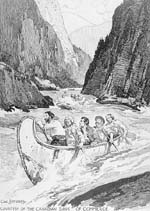
![[graphic]](91/h3-vtb51.jpg)







![[graphic]](91/h3-vtb00.jpg)
|

|
Simon Fraser and the Roller-Coaster River
Transportation
Fraser did most of his travelling by canoe and on foot. The canoe of the time was made with a wood frame and covered with the bark from a birch tree. It was very light and could be carried easily past dangerous rapids and waterfalls. This was very important on the rough rivers he travelled.
 |
Simon Fraser descending the Fraser River, British Columbia, 1808
Copyright/Source |
Better than Any Amusement Ride!
Imagine traveling through 3 miles (5 km) of rapids and whirlpools, clinging to an upturned canoe. That's exactly what happened to one of Fraser's men. This is how the paddler described it:
"I continued astride the canoe… I scarcely had time to look about me… In the second or third cascade the canoe plunged from a great height into an eddy below, and striking with great violence against the bottom, split in two. Here I lost my recollection… I soon recovered and was surprised to find myself on a smooth, easy current, with only one-half of the canoe in my arms."
Livesey, Robert. The Fur Traders, Toronto: Stoddart, ©1989, p. 55.
This is Heavy!
Along canoe routes, explorers and voyageurs would have to change from one river or lake to another. It was rather like changing from one highway to another. Sometimes the water was too rough to be able to continue. The canoe would be hoisted above the paddlers' heads and, along with their supplies and loads, carried to wherever it could be put back in the water. This was called portaging, and sometimes the portage went on for miles.
|
